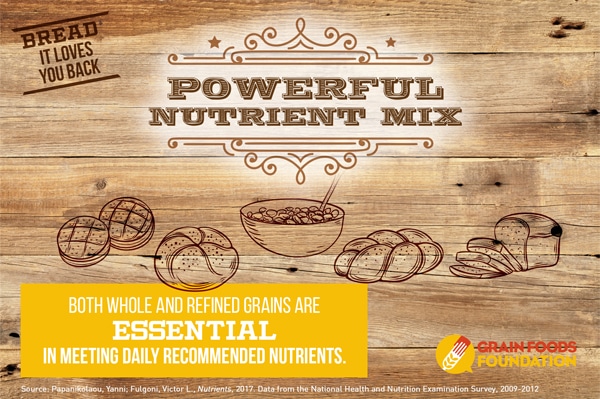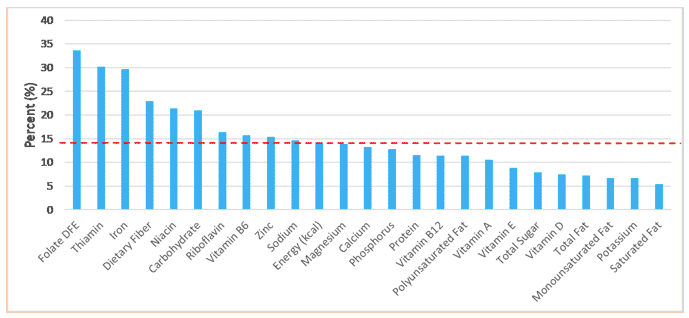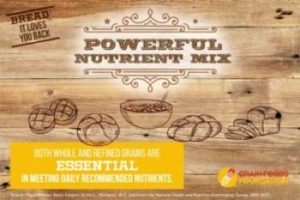 Everyone is on the hunt for the latest superfood, yet sometimes nutrient-rich foods are hiding in plain sight. Health professionals agree that it is the total diet that is important and all foods fit to contribute to our health at every age. A tasty, healthy, and enjoyable pattern of eating is the goal for all Americans and these three attributes are all possible.1
Everyone is on the hunt for the latest superfood, yet sometimes nutrient-rich foods are hiding in plain sight. Health professionals agree that it is the total diet that is important and all foods fit to contribute to our health at every age. A tasty, healthy, and enjoyable pattern of eating is the goal for all Americans and these three attributes are all possible.1
One food that we love, and that we know can love us back, is grains. In a new study2, researchers wanted to determine food sources of nutrients in the American diet. Over 10,000 dietary surveys from adults over the age of 19 were collected by the National Center for Health Statistics of the Centers for Disease Control and Prevention (CDC). This is a nationally representative survey of community-dwelling adults. The researchers looked at all data on grain consumption and classified it and analyzed the following grain food groups:
- All grain foods
- Breads, rolls, and tortillas
- Ready-to-eat cereals
- Cooked grains
- Quick breads and bread products
- Sweet bakery products
Data were analyzed for men and women, and looked at the contributions of all grains and the various sub-categories (listed above) with vitamins, minerals, and dietary fiber. The researchers were especially interested in how grains contribute to under consumed, or what are called shortfall nutrients. These include fiber, folate, magnesium, calcium, and iron.
The results might surprise those who think carbohydrates, and especially grains, are the fattening enemy. All grain foods provided about 14% of total calories (or about 285 calories per day). Consider that a medium soda fountain soft drink (22-ounces) has 285 calories, yet provides no fiber, vitamins, or minerals. Grain foods, on the other hand, are nutrient-rich and provided meaningful contributions to the shortfall nutrients of fiber, folate, magnesium, and calcium. The figure shown below shows the grain food sources of calories and nutrients for men and women. In addition, the bread, rolls, and tortilla sub-group provided B-vitamins and zinc, along with the other short
fall nutrients. So, know your stuff before you cut out bread from your diet.

Figure 1. Grain Foods Sources of Energy and Nutrients for Adults2
Another interesting finding from this study is that most of the grains analyzed were refined, enriched grains. About 95% of Americans don’t consume the minimum recommended servings of whole grains, so those who consume whole grains might be getting even greater fiber intakes. Enriched grains are nutrient-rich, as shown in this study. Enrichment is a process of adding nutrients lost in processing back into grains; fortification is the addition of nutrients not naturally occurring in the food to protect public health. Grains are enriched with B-vitamins and iron and fortified with folic acid, a B-vitamin. Since grains were fortified with folic acid in 1998, the CDC reports that there has been a 36% reduction in neural tube defects in newborns and prevented an additional 100,000 neural-tube defect-affected pregnancies, recognizing folic acid fortification of grains as one of the greatest public health accomplishments.3
There are many healthful eating patterns…from Mediterranean to vegetarian… and all include grains. The Dietary Guidelines for Americans emphasize choosing a meal pattern with a variety of foods that are nutrient-rich with proper portion sizes4. Grain foods can, and do, fit into every healthy meal plan and are meaningful contributors to shortfall nutrients.
References
1Position of the Academy of Nutrition and Dietetics: Total Diet Approach to Healthy Eating. J Acad Nutr Diet. 2013;113:307-317.
2Papanikolaou Y & Fulgoni VL. Grain foods are meaningful contributors of nutrient density of American adults and help close nutrient recommendation gaps: Data from the National Health and Nutrition Examination Survey, 2009-2012. Nutrients. 2017: Aug 14;9(8). pii: E873. doi: 10.3390/nu9080873.
3Koppaka R. Ten great public health achievements—United States, 2001–2010. MMWR. 2011; 60: 619–623.
4Dietary Guidelines for Americans 2015-2020, 8th edition. https://health.gov/dietaryguidelines/2015/gui

